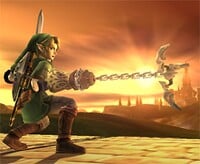Hookshot: Difference between revisions
No edit summary |
|||
| Line 21: | Line 21: | ||
</gallery> | </gallery> | ||
[[Category:Attacks]] | [[Category:Attacks]] | ||
[[Category:The Legend of Zelda universe]] | [[Category:The Legend of Zelda universe]] | ||
Revision as of 05:47, February 6, 2009
The Hookshot and the Clawshot are grab moves performed by Link and Young Link in Super Smash Bros. Melee and Link and Toon Link Super Smash Bros. Brawl. The hookshot is a recurring item in the Legend of Zelda universe.
Hookshot
The Hookshot is Link's grab in Super Smash Bros., Link's and Young Link's grab in Super Smash Bros. Melee and Toon Link's Grab in Super Smash Bros. Brawl. In Super Smash Bros. Melee, Link/Young Link used this to perform the wall-grapple. In SSBM, the hookshot can latch to essentially any wall at any point at appropriate distances. Using this technique one can use mind games to assist in recoveries by choosing either to sweet spot the ledge or grapple another point of the wall; however, should the wall-grapple miss or otherwise fail, Link/Young Link will be left in the "helpless" animation. Additionally, the hookshot may be used immediately after an air-dodge.
In Super Smash Bros. Brawl, Toon Link uses his to perform the Tether Recovery and grab. Similar to Link's clawshot, if it misses, Link is left wide open. It also has two hitboxes that follow the same mechanic from Link's Clawshot. In SSBB, Toon Link's Hookshot has a shorter range in grabs and tethers compared to Link's Clawshot, but this makes it slightly faster.In Zelda games the Hookshot was not as useful as the Clawshot. Also, in TP, you could get two Clawshots. As is the case with all tether-recoveries in SSBB the clawshot/hookshot may only latch onto the ledge, making edgehogging the recovery relatively easy.
Clawshot
The Clawshot is Link's grab in Super Smash Bros. Brawl. Although it's very similar to the the Hookshot in Super Smash Bros. Melee, not only does it retract more quickly, but Link's new Tether Recovery now finds and tracks the wall, automatically sweetspotting a nearby ledge instead of just latching onto it when it touches. Also, when used in the air to attack, there are two different hitboxes. The first is when the claw is shot out, and hits the opponent. The second hitbox is at the end of the Clawshot, when the claw closes. Also, if Link lands while using the clawshot in the air, the move auto-cancels, which is a useful technique when combined with SHFFL, quite possibly Link's best tactic for interrupting other characters' approaches. If the player misses while using this on the ground, there is a large ending lag that leaves Link very vulnerable to attack. It should also be noted that if it fails, Link doesn't enter Helpless state. In most cases it's recommended to use the Clawshot for recovery because it helps prevent Link from getting edgeguarded by certain attacks.
The Clawshot has an invaluable edgehogging property in that it can quickly give Link more invincibility frames by pressing back after Link has grabbed the edge, and immediately pressing "Z" releasing the clawshot, and pressing "Z" again to instantly grab the ledge and gain invincibility frames. This technique is sometimes referred to as Zair Edgeguarding, even though it is used as an edgehogging technique.
The reason that the two are named differently is that Link in Super Smash Bros. Brawl is based off of his "Twilight Princess" model, where the item in the game is called the "Clawshot" instead of the old "Hookshot" from Ocarina of Time.

